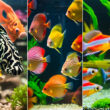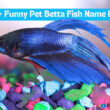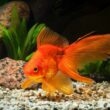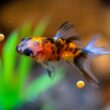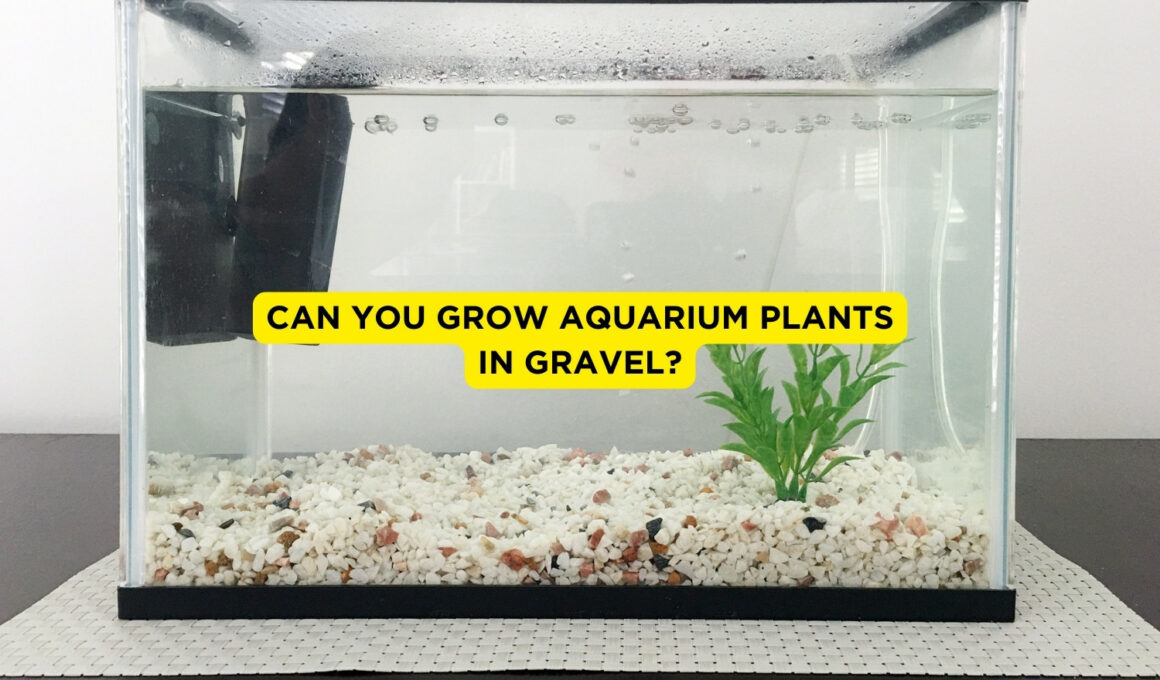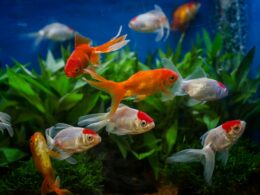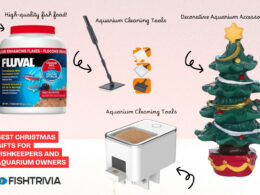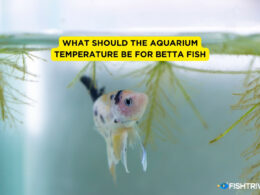In this article Show
You might have seen the bed where fertilizer, natural to be specific, is made, you will find plants, plants like plankton or small plants. Fish tank gravel is the place where starting from food waste to fish waste falls. Which makes it perfect for small fish tank plants to grow.
Many hobbyists would like to learn how to plant the best gravel substratum, what is the best aquarium gravel, and whether aquarium plants can thrive on rocks in a grave substratum.
In this rocky substance, not just any plant can flourish. You also ought to be careful how those plants are put in the gravel. For particular species, certain care requirements are needed. These must be followed so that plants in this form of material are successfully grown.
In reality, it depends on which plant species you have. Gravel is typically a fantastic material in which plants are grown. But in this substratum, only some flora can well expand.
Rock gravel is designed to clean quickly and cover garbage. The surface of the substance is easy to adjust and appears to be non-porous to resist biological adhesiveness to make clearing to removal easy.
In this article, we will show you the aquarium plants which can be stored in an aquarium with a gravel substratum. But first, we will have to know some important aspects that will help us to know about planting the plants.
What To Know About Planting In Gravel
Here is what to know about planting in the gravel;
1. Setup
Establishing a new tank, after all the supplies have been obtained, is an enjoyable experience. The way to the health and longevity of the aquarium is to use a substratum well-built for plants.
2. Layering
For better results, it is advised that the gravel is spread at least 2 to 3 inches higher than the aquarium surface. Using fertilizers for gravel is an ideal way to start plants to grow as a whole. Before adding to the plants, the aquarium should be filled with water about halfway.
Growing gravel aquarium plants are simple as the roots and bulbs should be put in the gravel carefully and protected to ensure good growth. Any items such as rocks and furniture can be inserted until the tank is filled with extra water for a customized touch.
3. The Thickness Of The Gravel
It is strongly recommended for your aquarium to use uncoated pea gravel or sand. The size of the gravel is also critical for the life of the plant, hence it is recommended to adhere to three to five mm of grain. The aquarium also embraces sand in courses in .12 to .20 inches. It is also best not to buy any gravel that is epoxy-coated because it does not fit properly with the tank.
4. Lighting
When they get no less than eight hours of sunshine, aquarium plants do well. The overall recommended duration is twelve hours of light and fluorescent ampoules are also recommended.
These lamps will span the entire spectrum and the plants can be protected under the lights directly. The amount of light required for the cultivation of aquarium plants in gravel depends on the tank size. Ten-gallon tanks normally need a tube of 15 watts whereas two light bulbs are required to create a tank of 40 gallons
5. After Setup
Make sure you pick plants with root systems that grow quickly and are easily attached. The hair grass plant is among the best plants for our aquarium. This is one of the best plants to buy and can grow on the aquarium surface.
If you don’t want to apply a substrate to your tank, anchors are a perfect way of operating. Porous organic materials perform extremely well. Driftwood is my preference. The inclusion of root register fertilizer is a perfect way to accelerate the root growth mechanism.
Even plants’ root systems can be rooted to the bottom of your tank with the right fertilizer. Moreover, the iron reduction properties of Seachem Excel can lead to preventing low pH levels that are toxic to plants. A full limit of around 40 liters of water is added to the fertilizer.
Afterward, a full limit is added to a 50-gallon tank. Now, it is time to get introduced to some famous fish tank plants that can be grown in the gravel. Let’s get started.
Best Aquarium Plants in Gravel
The following are the best aquarium plants that can thrive in the gravel;
1. Dwarf Sagittaria
The Dwarf Sagittaria is the last plant on this list. This is one of the better alternatives for the aquarium if you are looking for a rugged and adaptable species.
In America and Columbia, Dwarf Sagittaria typically enjoys moderate temperatures in water. In a bath with a tougher pH, they would not have a hard time. Growing Sagittaria is relatively simple and can tolerate high pH and rough water conditions in one of the very few aquarium plants.
Substrate your Dwarf Sagittaria in a rich substratum with nutrients like sand, or fertilize your water column daily if you have a gravel medium that is slightly difficult to apply.
2. Cryptocoryne
This is one of the hardest aquarium plants that grow in light and soft and rough water. It is also excellent for the soft and hard environments of water and is very versatile because of the many diverse colors for aquascaping.
The main point to be mindful of crypts is that they do not enjoy volatility. Plants and replants can cause the plant to die and delay growth. With the Wendtii, treatment is very easy. It’s a powerful plant that likes a lot of water. This plant likes low light, and can also survive in several ph temperatures.
Although this plant is undemanding, you must root it down as easily as possible. Wendtii plants are big root systems, which makes gravity an ideal substratum for species. Make sure the roots are securely planted and that there is plenty of gravel in the reservoir. Three inches max!
3. Anubias
Anubias is an aquatic-semi-aquatic plant genus that is distinguished by broad, dense, and dark leaves in various types. For aquarium usage, anubias nana, anubias barteri, and anubias var nana are the most common species. anubias barteri var nana.
These plants are very hardy and most beginners will survive. The plant is therefore very short and can thus be grown in a tank of around 10 gallons.
Medium-light functions well for the Anubia, but higher light levels can be used if you want the biggest possible plant. Fertilizer is not a must for an Anbubia since its growth is very good on its own, but consider placing root tabs or other nutrients in gravel so that it preserves good health and color.
4. Amazon Sword
It comes from a diverse Amazon basin. This aquatic plant originates from Echinodorus amazonicus, though there are other forms, and is the species mostly planted in aquariums.
Amazon’s sword is stunning, simple to care for, and has a forest-like effect inside the tank with a bladelike appearance and incredible stamina. For newcomers and seasoned aquariums, it’s perfect.
Even in your aquarium, this plant looks amazing. It has long sword-like leaves that can be put alone in the middle of your tank, or it can be grown in the backdrop of your tank. This flora can grow long and robust with little upkeep.
It is a very good plant for a cold water aquarium. This plant can grow as low as 60 ° Fahrenheit. It’s still a very good plant for oxygenation.
5. Java Fern
Born in Malaysia, Thailand, Northern India, and parts of China, this plant is named after Java Island. The delicate fern provides the aquariums with a majestic look and is commonly used because of its gradual growth, its special form, and ease of reproduction and treatment.
The aquarium will grow in gravel or aqua soil based on at least 10 gallons, or it will be attached to a log, rock, or another decor. It will grow. During floating, Java fern can also rise. Ses plants are also in your tank area for your fish.
The leaves of the Fern are wide and protect all sorts of species. Java is not rising crazily quickly, but you can have an entire tank packed with all this flora over time.
One thing to remember, though, is that a Java fern plant could also need support for something else, even if buried in a substrate. Moreover, the plant should only be buried for a brief amount of time, so it can die as the rhizome roots.
6. Vallisneria
Vallisneria is a tall, pink-like seagull-like herb. Therefore in the aquarium hobby, it is quickly propagated, and still very common.
Vallisneria is usually easy to develop in an aquarium until you want to keep it soft or acidic. Put it on the back of or along the sides of your fish tank because it is a tall herb.
The roots of Vallisneria should lie below the substratum, while the crown, in which the leaves rise, should be just above the surface of the gravel. The Vallisneria Jungle can withstand virtually any illumination.
It can live in low illumination conditions and develop rapidly under high illumination conditions.
You should preferably sustain it at a minimum of 3-4 watts per gallon under mild lighting conditions. In a tougher ph level, Vallisneria is rising high and lush. The air on the colder side is expected to be once again. And you want to cut it so that it doesn’t overwhelm your tank. Vallisneria can develop in gravel, but not much of it is required.
7. Anacharis (Water Weeds)
Brazil, Uruguay, and Argentina are native to Anacharis and are now producing prolific growth in North and South America. It is a prominent plant that is commonly found in fish shops. The dark green leaves of the plant create a lush visual look in aquariums, which act as a source of food, and a water purifier which is a sanctuary for the use of shy fish.
Put the anchors into a watermark or a rich substrate, each one roughly 2 inches deep and 1 or more inches apart, to create anchors. However, try medium light to illuminate your plant for the best plant growth. To achieve its maximum capacity, fertilizer can also be used along with colder water if you want a larger plant.
However, colder water will delay its development if you want to regulate the scale of your waterweed better. Place this flora on gravel and make sure that you are firmly entrenched.
These above-mentioned plants are the best and most famous to be planted in your fish gravel. Now, as we talk about gravel, we could find some major questions, which are frequently asked;
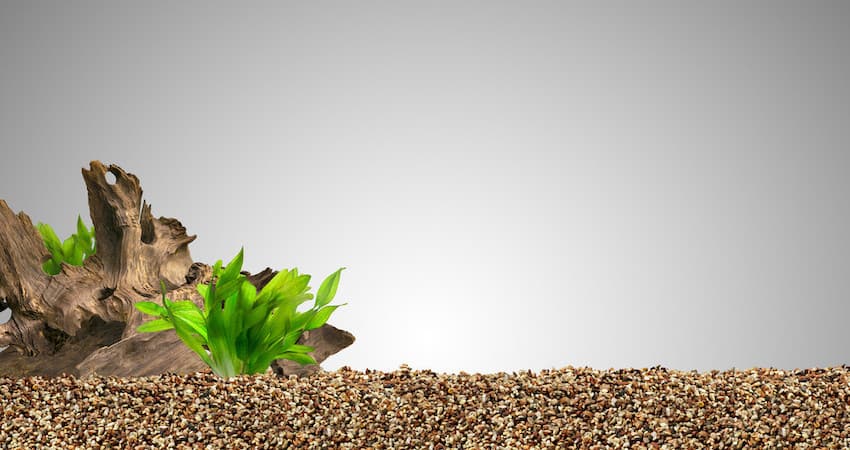
Best Gravel For Plants
It is said to help the growth of more plants than other gravel types in fine grain, pea substrates like the seachem black clay gravel. Therefore, large chunky, boundary rocks of fish safe and gray are better unless you intend on growing plants, such as the Bucephalandra, of heavy root systems.
You may also want to use nutrient-rich substrata, such as Flourite, black sand that is rich in organic elements and nutrients, and provides better conditions for the growth of aquatic plants than gravel, if you want to grow substratum feeders.
In plants that prefer to feed on the water column, light substrates are also recommended. And when Java ferns, anubias, swimming plants, and stem plants such as rotala indica are grown, premium nutrient-rich gravel will contribute to a costly substrate for these plants which will do nothing.
Can Gravel Be Rocky?
In reality, some aquarium plants can be grown on rocks. Most of these are neophyte plants such as Bruce, which anchors on rocks, driftwood, and other decorations using their powerful root systems.
The Java Fern, Java Moss, the Magenta Water Hedge, and Dwarf hair grass are other common aquarium plants that grow on rocks.
Some like crystal word as floating grows marginally under heat, so the usual way to get them to grow correctly is to position them on rocks, wood, and fishing wires.
Verdict
Thus, these are the perfect gravel substratum aquarium species. However, little analysis might be required. The specifications for substrates are not the same. Plants that require a deep root need more gravel. There are no other plants in a bunch of gravel that are buried. So note that!
Make sure the gravel stays safe. The gravel of the aquarium continues to be dirty. And if you want your plants to remain healthy, then you have to keep them healthy. More gravel would certainly lengthen this cleaning process, but this is a crucial step.
Good luck with your Fish Tank!!
To Grow Aquarium Plants In Gravel You Should watch the video below:


